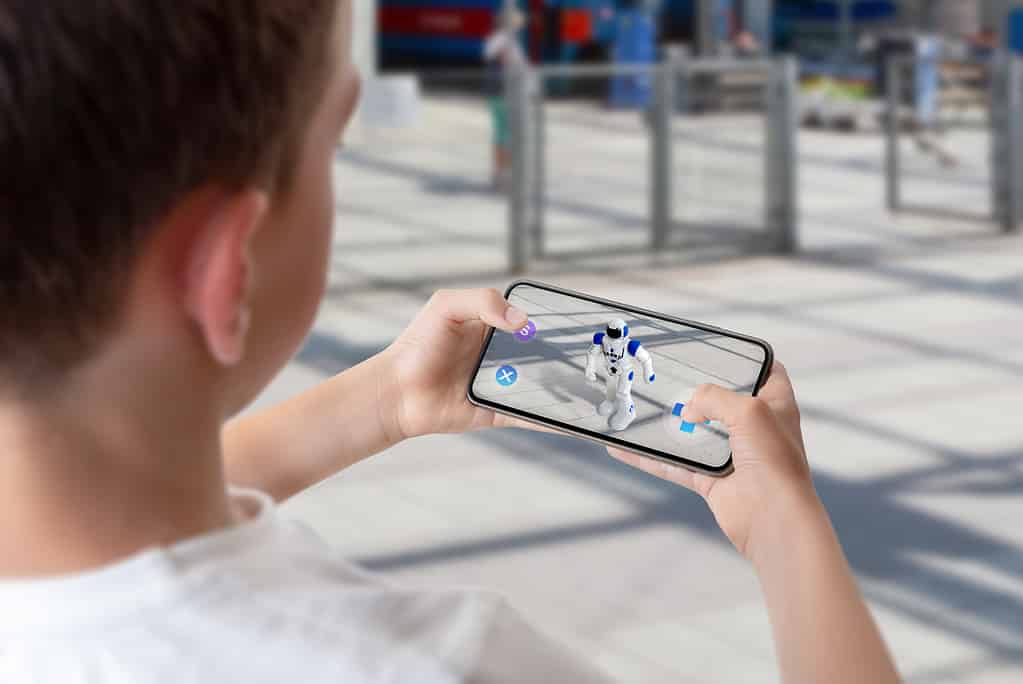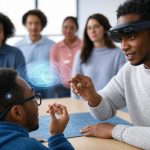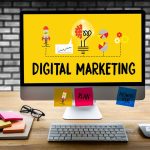

Imagine a world where you can virtually try on clothes without entering a store, explore a museum from the comfort of your home, or interact with digital advertising in real time. Welcome to the era of augmented reality (AR) marketing. This rapidly evolving technology is changing the way brands engage with their customers, offering immersive and interactive experiences that go beyond traditional marketing methods. In this blog post, we dive into the world of augmented reality marketing and explore its evolution, applications, real-world examples, and future potential.
Unlike virtual reality, which creates an entirely digital environment, AR combines the real world with digital elements, enhancing users' experiences and providing additional information through the use of augmented reality technology.
AR marketing has many applications, with retail, tourism and advertising being the most important. It is gaining popularity as a tool to promote products and services, thanks to its captivating AR feature. Factors such as AR marketing strategies can influence the effectiveness of these campaigns, taking into account variables such as:
The following sections look at the evolution of AR technology, its various applications, and the challenges marketers face when integrating AR into their marketing strategies.
The release of Pokémon GO in 2016 was a turning point for AR, introducing the technology to a mass audience and sparking interest in its potential applications in various industries. The main application areas for AR marketing are retail, tourism, and advertising. Retail in particular saw the most journal articles published on AR marketing, highlighting the promising future of the technology in this sector.
Early AR systems encountered limitations in their applications in the business environment. They required specially installed devices or AR glasses or complex installations. However, the development of AR capabilities for mobile devices has greatly expanded the reach and potential of AR marketing. The emergence web-based AR applications (WebAR) makes it easier for consumers to access AR content. The content is simply accessed through the brwoser from a website and no longer requires an app actually programmed for it. This significantly lowers the barrier for audiences to also access and interact with promotional augmented reality content, further fueling the growth of this technology.

In marketing, the following different AR applications are used e.g.:
These augmented reality applications, enable increased customer engagement. They interact with the user's physical space to create immersive experiences and blur the line between the digital and physical worlds. For example, web-based AR applications allow consumers to virtually try on products such as sunglasses, watches, makeup, clothing, shoes and furniture already in place.
The application potential of AR in online and offline marketing is enormous. In the online sector, AR can improve the experience of customers and tourists and increase their satisfaction with online retail, virtual tourism and online advertising. This enables a more attractive online shopping experience and virtual exploration of destinations.
In offline marketing, AR can enhance the appeal of physical stores, restaurants, museums, and art galleries by providing consumers and tourists with unique and engaging experiences.
Augmented reality marketing has been successfully implemented in various industries, demonstrating the versatility and effectiveness of this technology in engaging consumers and driving results. The research sheds light on the potential of AR marketing in retail, tourism, and advertising, showing its ability to create memorable and immersive experiences for consumers.
Some notable examples of successful AR marketing campaigns include:
The IKEA Place app at retail, which allows customers to virtually set up furniture in their homes before making a purchase
The British Museum's AR app in the tourism and culture industry, which provides users with a virtual environment to explore the museum's exhibits
Pepsi Max's AR campaign in the advertising industry, which allows users to interact with virtual Pepsi Max cans in their environment
These campaigns illustrate the power of AR in creating engaging and interactive experiences that resonate with consumers and drive results.
Retail
In retail, AR has been used to enhance the customer experience, increase sales, and build an emotional connection with the brand. For example, the IKEA Place app allows customers to virtually place pieces of furniture in their homes to visualize how the products would fit and look in their living spaces. This AR experience improves cognitive control, fosters stronger engagement with one's brand, and reinforces perceptions of utility and hedonic value, driving consumer purchase intent.
Research related to augmented reality (AR) in retail focuses on technology, product, and brand outcomes. Several literature sources provide contextual analysis on these variables. Two streams of literature focus on the impact of AR use and the impact of AR characteristics on product-related outcome variables.
Creating a seamless shopping experience with AR enables brands to increase customer satisfaction, drive product sales, and foster emotional connections with their target audience.
Tourism and culture
In the tourism and cultural industries, AR can be used to provide visitors with immersive, interactive, and personalized experiences. Much of the current research on the use of AR in tourism focuses on offline scenarios. The literature on augmented reality in tourism examines technology-related and destination-based outcome variables. The findings can guide further research in this area.
One example of a successful AR marketing campaign in the tourism and culture industry is the British Museum's AR app. This app provides users with a virtual environment in which to explore the museum's exhibits, creating an engaging and immersive experience for visitors. By integrating AR into the tourism and culture sector, organizations can attract more visitors, increase customer satisfaction, and create memorable experiences that resonate with their audiences.
Advertising and sales promotion
Advertising and promotions play a critical role in AR marketing, focusing on the use of augmented reality technology to create immersive and interactive ad campaigns that can increase engagement, improve ad recall, and stimulate purchase intent. Factors such as brand congruence, self-reference, and perceived humor have been found to influence consumer purchase intent with AR advertising. In addition, research has shown that these factors significantly influence consumers' attitudes toward the advertised brand after use.
An example of a successful AR marketing campaign in the advertising and promotions industry is the Pepsi Max AR campaign. This campaign allowed users to interact with virtual Pepsi Max cans in their environment, creating a fun and engaging experience. By using AR in advertising campaigns, brands can increase customer engagement, improve ad recall, and drive purchase decisions, ultimately leading to higher product sales and increased brand awareness.
In order to create a successful AR marketing campaign, it is important to develop a well-defined strategy that includes the key components of AR marketing. This includes:
In addition, integrating AR experiences with other media or brand-related cues can help achieve overarching marketing goals. Choosing the most appropriate AR platform for your marketing strategy depends on your goals and the type of AR experience you want to create. Factors such as platform capabilities, user experience, and cost should be considered.
continues, it's important to establish metrics to track the performance of your AR marketing campaign and make data-driven decisions for future improvements. By setting clear goals, choosing the right platform, and measuring success, you can ensure a targeted and effective approach to AR marketing.
Defining the goals of your AR marketing campaign is critical to a targeted and effective approach. Goals may include:
Setting clear goals not only ensures that the AR marketing campaign is focused on the desired outcomes, but also facilitates measurement of the campaign's success and data-driven decisions.
A clearly defined action plan, the use of suitable AR platforms, and an evaluation of the campaign's success are necessary to achieve the set goals. Clear goals and strategic implementation pave the way for a focused, effective AR marketing campaign that resonates with your target audience and delivers results.
Selecting the most appropriate AR platform for your marketing campaign is critical to creating a seamless and enjoyable user experience. When selecting an AR platform, you should consider aspects such as the target audience, budget, and desired user experience. Some of the most effective augmented reality platforms are:
For AR apps on mobile devices like phones and tablets:
Social media platforms also already offer AR integrations :
Each platform offers its own set of features and capabilities designed to meet different marketing objectives and user experiences.
Researching and comparing different AR platforms is an important step in reaching your marketing goals and target audience. Choosing the right platform promotes a seamless, enjoyable user experience that leads to increased engagement and successful marketing results.
Establishing metrics to track the performance of your AR marketing campaign is critical to monitoring success and making informed decisions about potential improvements. When evaluating the success of your AR marketing strategy, you can track metrics such as user engagement, brand awareness, and revenue. In addition, surveys and focus groups can provide valuable insights into user experience and satisfaction, allowing you to make data-driven decisions for future improvements.
Evaluating the success of your AR marketing campaign provides insight into its effectiveness and identifies areas for improvement. Using a data-driven approach helps you refine your marketing strategy, create engaging experiences for your audience, and drive better results.
Although the potential of AR marketing is immense, several challenges must be overcome to ensure successful implementation. These challenges include technical limitations, user experience issues, and privacy and security concerns.
The following subsections take a closer look at these challenges and explore possible strategies to overcome them. Overcoming these challenges and leveraging the strengths of AR marketing enables brands to create engaging, immersive experiences for customers while minimizing potential risks. This balanced approach ensures that AR marketing campaigns are not only engaging and effective, but also safe and user-friendly.
Technical limitations of AR marketing include:
The cost of developing an AR application can range from several thousand to hundreds of thousands of euros, depending on the complexity of the project.
To overcome these technical limitations and proprietary hardware adaptations, marketers can use cloud-based WebAR solutions that serve both Abdroid and Ios. It is important to understand the technology behind augmented reality to make the right decisions for your AR marketing campaign.
User experience
User experience challenges in AR marketing include difficulty navigating the user interface, understanding the content, and understanding the context. To overcome these challenges, it's critical to develop an intuitive user interface, provide engaging content, and leverage immersive technologies such as 3D and 360-degree video. Be aware that text-heavy applications do not work well in AR, as the readability of text is severely limited in 3D space.
Successful UX strategies can include incorporating interactive elements such as gamification, delivering personalized experiences, and using data-driven insights to optimize the user experience. By focusing on creating a seamless and enjoyable user experience, brands can ensure that their AR marketing campaigns resonate with their audience and drive engagement.
Privacy and security
There are privacy and security concerns in AR marketing. Illegal data collection and misuse, the possibility of data breaches and the risk of data manipulation even by third parties should be an issue that should not be neglected. Make sure that the frameworks you use are compliant with privacy policies.
The future of augmented reality marketing is very promising. Industry experts predict that augmented reality will continue to expand in the coming years and will be one of the fastest developing markets.
The widespread adoption of 5G connectivity will significantly enhance AR marketing capabilities and enable new, innovative applications. The benefits of 5G for AR marketing include:
Increased throughput and faster speeds that deliver an enhanced AR experience
Higher engagement and conversions due to improved AR experience
Streaming VR and AR content from the cloud, making it more accessible and immersive
The integration of 5G connectivity and augmented reality offers marketers the ability to create real-world experiences, such as virtual showrooms and interactive product demonstrations, that enable brands to connect the physical and digital worlds. By harnessing the power of 5G and AR, marketers can create engaging and immersive experiences that reach a wider audience and drive better results.






